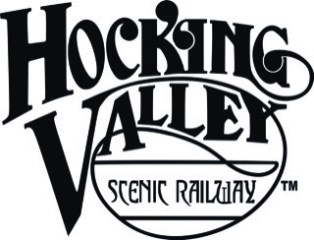Historic sites seen from the train!
The following historic sites can be seen along our route between Nelsonville and Logan. Note: Sites that can be seen on the right side of the train on the way up will be on the left side on the way back and vice-versa.
Nelsonville History: Nelsonville was named for Daniel Nelson, who came here with his family in 1814. The town was incorporated in 1838. Nelsonville would become known as Ohio’s coal center. Initially, the coal was shipped by wagon and then by canal, but both methods proved to be too slow and inefficient. When the Columbus and Hocking Valley Railroad reached Nelsonville in 1869, a boom came to the area. At one time, there were over 40 mines and mining communities served by the railroads in this area. Its past is still visible in the restored town square near our Depot.

1. Nelsonville Cross: The Nelsonville Cross can be seen on the right side of our train up in the hills as we leave town. It was erected in 1973 by a gentleman as a memorial to his wife, Betty. It is 65 feet tall.

2. Crabtree Field: This Nelsonville baseball park can be seen on the right side of the train as we leave town. It is named after former MLB player Estel Crabtree, who played for the Reds and the Cardinals. The unique thing about this park are the seats behind the backstop, which were made using stones from the Hocking Canal.

3. Brick Kilns: The clay industry was prominent in this area from the 1870s until the 1920s. The remaining kilns from the Nelsonville Brick Company can be seen on the left side of the train shortly after we pass the fire station. The remaining kilns from the Nelsonville Brick Company have been restored and serve as a reminder of the area’s brick-making industry. The company produced both paving bricks for roadways and decorative bricks, known as Star Bricks because of the unique star design on their tops. Star Bricks were widely used for sidewalks and railroad depot platforms. The Hocking Valley Fire Clay Company was also located along this route, but the plant has since been razed. The building still stands and is occupied by the local VFW.

4. East Clayton/Bridge 595: East Clayton was a small company town that produced bricks. The plant was destroyed by fire in the 1890s. A coal branch once extended away from the town and served the Lick Run Coal Mine. Bridge 595, located near East Clayton, is one of three Hocking River crossings on our route. This bridge was located 59.5 miles from the former Columbus Union Station. The bridge once held two tracks. Once across the bridge, the tracks merged into one and continued west toward Logan. Other Hocking River Crossings on our route include Bridges 617 and 629.

5. Hocking Canal: After crossing Bridge 595 on the way up, keep your eyes open on the right for Hocking Canal Lock No. 19. It is located along old U.S. 33 at Johnny Appleseed Roadside Park. There were once wooden gates at each end of the locks, which allowed the barges to move from one water level to another. The Hocking Canal reached Nelsonville in 1840 and Athens in 1843. The barges were small by today’s standards. The canal was about four feet deep and 30 feet wide. Teams of mules and horses pulled the barges along with a speed limit of 4 mph to keep the wake created by the barges from eroding the sides of the canal. The flood of 1873 and the coming of the railroad eventually put the canal out of service.
Haydenville history: Haydenville was named for businessman Peter Hayden and was a company town constructed to showcase the clay products manufactured by the Haydenville Mining and Manufacturing Company. It remained a company-owned town until 1963, after which, the houses were sold to their occupants. Many of the old company houses are still standing and are still occupied.
6. Round house: Get ready on the right side as we pass the pallet plant in Haydenville, and you will see the the round house. This round house is one of Peter Hayden’s unique designs. It was constructed out of silo brick and was one of six in Haydenville. It is the last one remaining and is on the National Register of Historic Places.

7. Haydenville Church Campus of Ebenezer Baptist: Look on the right side of our train in Haydenville for this quaint brick church. It was built using every style of brick produced by the Haydenville Mining and Manufacturing Company. The window on the west side honors Peter Hayden, who died before it was completed.

8. Sand and gravel quarries: The sand and gravel quarries that can be seen along our route can reach depths of up to 100 feet. Dredges, that appear to be boats, pump sand and gravel in a slurry form back to the plant, where it is dried and separated by type. The lake at the end of our route is now used for private recreation.
To learn more about the history of the railroad, click here. To learn about the history of our equipment, click here.
